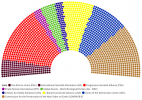Just a few infoboxes from the main Marvel Comics Universe and one (2013) from the Ultimate Marvel Universe.






Very interesting, I like the implications of this. I am curious why anarcho-syndicalism isn't listed as a variant of syndicalism here, however, as the origins of anarcho-syndicalist arguably predate the presumably early 20th Century POD you have here.View attachment 890932
The Worker's Scarlet Banner: Syndicalism in a tl with no French Revolution (and no left-right politics)
Well, there isn’t a French Revolution (which most historians put before the 20th century), which could affect things.Very interesting, I like the implications of this. I am curious why anarcho-syndicalism isn't listed as a variant of syndicalism here, however, as the origins of anarcho-syndicalist arguably predate the presumably early 20th Century POD you have here.
Ah, I was thinking this was a Kaiserreich alternate history and the French Revolution in question was the syndicalist revolution in France from KR.Well, there isn’t a French Revolution (which most historians put before the 20th century), which could affect things.
The "spot in the three pillars" intrigues meView attachment 890932
The Worker's Scarlet Banner: Syndicalism in a tl with no French Revolution (and no left-right politics)
Anarcho-syndicalism ittl is 'Freedonian' Syndicalism, compared to the more Statist 'Federalist' Syndicalism (named after the Federalist Party, long story)Very interesting, I like the implications of this. I am curious why anarcho-syndicalism isn't listed as a variant of syndicalism here, however, as the origins of anarcho-syndicalist arguably predate the presumably early 20th Century POD you have here.
ttl's political system is based on 3 pillars instead of a compass (Syndicalism Argentine-Mountain-Populare)The "spot in the three pillars" intrigues me
A pluricontinental Portuguese federation 😍😍The Pluricontinental Games
View attachment 891357
At this point it's a miniseries, I should probably put it in my signature...A pluricontinental Portuguese federation 😍😍
Wasn't Hayakawa born in Canada?FDR: The Five-Term Wonder

Correct, the 22nd ITTL also repeals the natural born clause.Wasn't Hayakawa born in Canada?
That seems random.Correct, the 22nd ITTL also repeals the natural born clause.
It was an idea a couple of members of Congress floated at the time, but it never got anywhere.That seems random.
Light of the Nation - Part 6: Far Far Away
Light of the Nation - Part 6: Far Far Away
Walter Mondale’s foreign policy in one word? Restraint. He’d seen what Vietnam had done to Johnson and Humphrey. No grand adventures.
And yet the hot sands of the Kalahari desert would present him with one of the great Cold War crises.
Mondale was no pacifist, and the Iranian Civil War had ended detente. “Good Fences Make Good Neighbors” was the phrase of the day. Pro-Washington Regimes would be bolstered, but escalation against Soviet influenced areas would not follow behind it.
In practice this meant limiting support towards groups like the Contras in Nicaragua, although aid to nearby dictatorships often served a similar role. UNITA, opposition in Ethiopia and Cambodia would all find the Mondale Government tight fisted, much to the fury of right wingers.
There were, of course, exceptions. Pressure from Catholics and Poles forced Mondale to slap harsh sanctions on Poland for repressing Solidarity. And when Communist infighting on Grenada broke out, Mondale’s CIA helped break it completely.
However Mondale remained on decent terms with his great power counterparts. Thatcher was a key cooperator in Grenada, and Mondale repaid the favor in the Falklands. Visits to China continued the process of opening started by Nixon. Relations with Moscow were cool but cordial.
However Mondale’s approach also meant buttressing some horrific regimes. Saudi Arabia, Zaire, most of Central America really. All in the name of preserving “freedom” the world over. Something of a sick joke, all things considered.
Public pressure did force Mondale to bow in some places. Congressional action got him to limit support for Indonesian occupations, when the Marcos government fell in the Philippines he did not fight back. However most consequentially he tightened sanctions on South Africa.
With both the SADF and UNITA lacking in resources, MLPA and Cuban forces were on the roll in Angola. In fact, by 1983, they were closing in on the border with South African occupied Namibia, which was already embroiled in an insurgency against the Apartheid regime. This was existentially threatening to P.W. Botha and the rest of the Government in Pretoria. Rhodesia had become Zimbabwe already, and if Namibia got worse…the apartheid regime might start to crack. Something needed to be done. Something drastic, to show the world resolve. On October 9th, 1983, sensors East and West observed major activity at the Vastrap Airbase in the Kalahari desert. Vela incident aside, it was South Africa’s first Nuclear Test, and was very much intended for public consumption. “Gemsbok 1” was a shot across the bow.
Mondale and the Soviets are, for once, of one mind. This is dangerous. Too dangerous to let anyone but the big boys handle. All the parties are dragged to Naples for a friendly “chat.” A permanent peace proved elusive, but the slouching towards Bethlehem was stopped at least. South Africa was to sign the Partial Nuclear Test Ban Treaty, leave Angola, and keep a “Demilitarized Strip” in the North of Namibia. In exchange the Cubans and Soviets pulled support from Namibian independence groups, and agreed to leave Southern Angola to the Angolans. There would be violations and recriminations and threats and death, but Mondale and his Foriegn Policy team had managed to avoid a full nuclear confrontation. Even if the right fumed for his “betrayal” of UNITA. South Africa was left nearly totally isolated, and stewed with rage.
Mondale’s Foreign policy occupies a transitional space in American policy. Vietnam Syndrome remained strong, but so to did a callous disregard for civilian life. Mondale faced just criticism and unjust criticism in his time, and history could only add to this mixed view.
View attachment 890313